
The measure of a man: Evaluating the role of astronauts in the Manned Orbiting Laboratory program (part 1)by Dwayne A. Day
|
| The purpose of the unmanned system would be a sort of insurance policy in case political considerations made a manned reconnaissance platform unacceptable. This decision naturally raised the question of why astronauts were needed at all if MOL could operate without them. |
While the public justification for MOL was vague, and publicly it was an Air Force program, MOL had a secret but clearly defined mission, and a secret sponsor: the National Reconnaissance Office (NRO). MOL would carry a powerful reconnaissance camera, code-named DORIAN, bigger than any optical system yet developed for space. The two astronauts onboard would point the camera at specific targets with higher precision than automatic systems could then accomplish. They would adjust the system and decide if the target was of sufficient interest to photograph, and they would also report what they saw to the ground. The astronauts would fly into orbit inside a modified Gemini spacecraft mounted atop the MOL laboratory, which featured a pressurized living compartment and a large unpressurized “equipment” compartment that housed the optical system.
A few months after MOL entered development, program managers decided to also develop an unmanned version of MOL, replacing the pressurized laboratory and Gemini spacecraft with a forward section carrying several smaller reentry vehicles that would be filled with exposed film. The purpose of the unmanned system would be a sort of insurance policy in case political considerations made a manned reconnaissance platform unacceptable. This decision naturally raised the question of why astronauts were needed at all if MOL could operate without them.
In early 1966, General Bernard Schriever, who had become famous as the father of the American ICBM program but by the mid-1960s had duties that included director of the MOL Program, called for a fast-track study of “the role of man in MOL.” The purpose of the study was to determine what value astronauts added to a mission that could be conducted robotically. Schriever recommended that MOL astronauts Al Crews and Richard Truly be consulted for the study, and also suggested that it could include NASA astronauts James Lovell, Ed White, and Wally Schirra. None of these astronauts’ names are listed on the final report, although they might have been consulted.
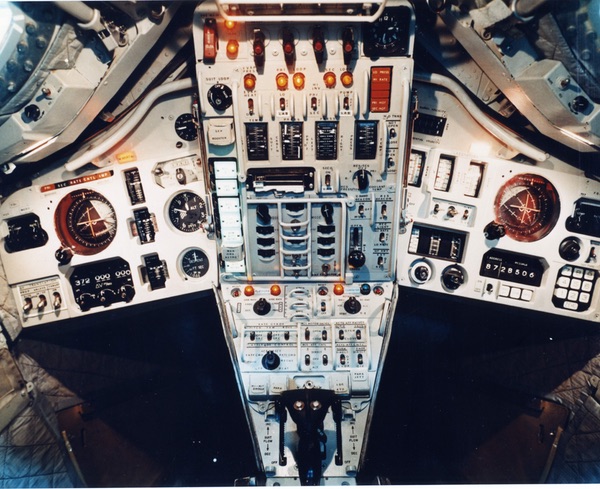 A mockup of the Gemini-B spacecraft controls. The Gemini-B was similar to NASA’s Gemini, but had a number of key differences, most notably a hatch between the astronaut’s seats so that they could crawl through a tunnel to the MOL pressurized compartment. The hatch opened through the Gemini’s heat shield. (credit: NRO) |
The study got underway in February and was finalized by May 25, 1966. The study group was chaired by Colonel Lewis S. Norman, Jr., with Lt. Colonels Stanley C. White, Benjamin J. Loret, and Arthur D. Haas of the MOL Program Office and Major Kenneth W. Weir of the MOL Systems Office. White was a flight surgeon and obviously familiar with the limitations of the human body. The report’s authors stated bluntly that “at the outset it was clear that there has been, is, and will continue to be, a need for a continuously updated rationale supporting the essentiality of man to MOL mission success.” They continued: “it must be anticipated that considerations of economy and the shifting international political situation, when viewed at the highest policy levels of government, will generate pressure dictating a periodic requirement to reassess the approach to the MOL program, even though the program currently provides for both manned and unmanned capabilities.”
The report’s authors talked to a lot of people throughout the MOL program and heard many different viewpoints. They thought that they got honest opinions and nobody was withholding information from them. They spoke to engineers, managers, and MOL astronauts, among others.
“Prior to initiation of this study, the consensus of the study group was that the rationale for including man in the MOL seemed to have deteriorated since program approval in August 1965,” they acknowledged. The reason was that new technology developments apparently threatened the original argument for MOL that a manned system could achieve very high resolution photography, but an unmanned system could not.
Perhaps what had people involved in the MOL program nervous was the impending debut of the GAMBIT-3 high-resolution photo-reconnaissance satellite. The first GAMBIT-3 launch took place in July 1966, several months after the report was completed. But by early 1966 the people involved in the technical aspects of MOL would have been aware of its optical system, which had been considerably upgraded compared to the GAMBIT-1 that had already been in operation for nearly three years. Although GAMBIT-3 could not achieve the same resolution as the DORIAN camera on MOL, it was expected to produce significantly higher resolution images than any existing reconnaissance camera.
After conducting their review, the study group became convinced that the argument for man was stronger than before. They sought to explore and explain the various reasons they believed that astronauts were still important for MOL.
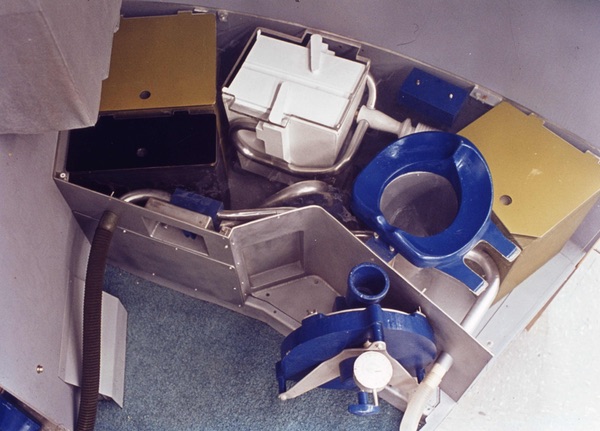 A mockup of the toilet that would be carried on MOL. Accommodating humans by providing life support, food, and hygiene facilities made MOL a more expensive program. (credit: NRO) |
The authors of the report concluded that any unmanned high-resolution reconnaissance system would have a high initial failure rate. This might not be a complete loss of the spacecraft or failure of the camera, but an unmanned system would not initially meet the goal for high-resolution photographs. They believed that inclusion of man “will virtually guarantee” earlier achievement of the resolution goal. “The underlying reasoning for this conviction is based on the inherent capability of man to more nearly guarantee a high probability of mission success—man’s inherent ‘reliability’—as opposed to that provided by automatic equipment.”
| “The underlying reasoning for this conviction is based on the inherent capability of man to more nearly guarantee a high probability of mission success—man’s inherent ‘reliability’—as opposed to that provided by automatic equipment.” |
The report authors believed that probability of mission success for a manned mission was high from the start, and would stay high, but would start low for unmanned missions and would only increase over time with launches, with a low initial improvement rate. They also concluded that an unmanned spacecraft would have a lower level of mission success than the manned MOL, no matter how many missions were flown and would never equal the success rate of the manned version. The graph they included in the report to illustrate this point had no figures on either axis, and was a best guess. The manned curve was typical of Mercury and Gemini experience, as well as experience with advanced aerospace vehicles like the X-15 and XB-70 bomber. They pointed out that in numerous instances “man has succeeded in mission accomplishment despite equipment failure.”
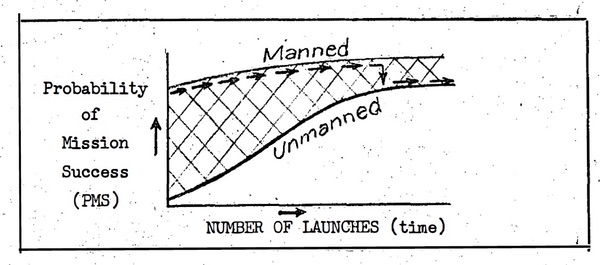 MOL program officials believed that the manned spacecraft would be more reliable than the unmanned version. (credit: NRO) |
The study authors also argued that it could make sense to use the unmanned system for operational missions after the system had been perfected with astronauts aboard. At that point the program could transition to a mix of manned and unmanned MOL reconnaissance missions. “Unmanned proponents argue that unmanned program experience and application of effort and quality control methods approaching those used in man-rating manned systems would insure early achievement of a reliable unmanned system, and that an unmanned program is more cost-effective over the life of an operational program.” But manned spaceflight proponents disagreed that unmanned systems would ever approach that level of reliability. They argued, for example, that man is “self-healing” and would not repeat a particular mode of failure. Astronauts were also “adaptable” and could find ways to work around a problem. Machines could do this too, but only for predicted failure modes. They argued that man’s performance does not degrade in a simple statistical manner but remains high.
Although the graph did not have numbers, the authors believed that by 1966 there was sufficient data available on both manned and unmanned spacecraft that actual statistical comparisons could be made. They suggested that it would be possible to look at data that NASA had already collected and was being used to establish contract incentive fee performance awards for McDonnell, which built the Gemini spacecraft.
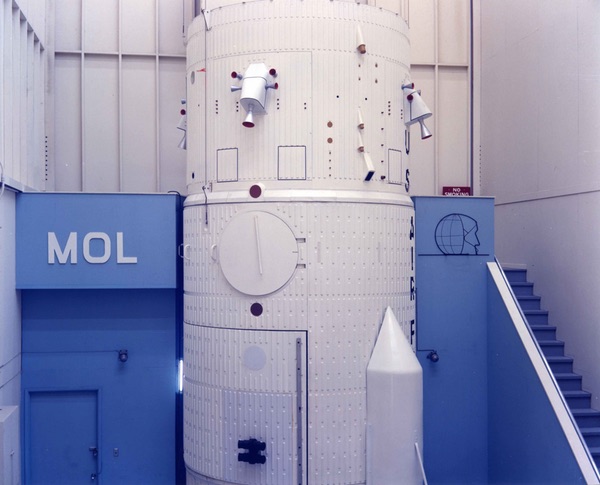 A MOL mockup. As the program advanced in 1966 and 1967, physical mockups were used to refine the design and the systems. (credit: NRO) |
In addition to achieving mission success faster than an unmanned system, “we believe that any DORIAN system growth to provide a capability for resolution approaching the atmospheric limit will require man’s presence,” the authors wrote. The atmospheric limit for a reconnaissance camera in low Earth orbit—dictated by immutable physics—is about six centimeters ground resolution. The authors did not believe that such very high resolution was possible with an unmanned system.
The report acknowledged that the cost of developing a manned system was quite large compared to the cost of the camera system. But the cost of the camera was not negligible, and in order to get the best return on investment, it made sense to extend mission operations as long as possible. The solution might be to make the MOL system serviceable by multiple astronaut crews.
| “As the study group sees it today, the unmanned developments—the classic threat of automation replacing man—are not to be dreaded but rather welcomed. They will largely free man from what are essentially routine and tedious mechanical jobs and permit him to make his contributions in areas which do not lie in the province of machines.” |
The authors sought to break down all of the relevant areas where humans offered greater capability over automated systems. They noted that “eight specific functions and capabilities were originally considered to represent man’s most important contributions in the conduct of the DORIAN mission.” They concluded that those functions were still valid and discussed each of them in detail.
The report stated that astronauts can be a powerful contributor to finding targets to photograph because of human ability to make real-time judgements. An astronaut could assess a target area, select the target of highest intelligence value in a cluster when the exact locations are not known, and evaluate cloud, haze, lighting, and shadow conditions. An astronaut could also select suitable alternatives when the primary target is obscured. In addition, an astronaut could spot new and unexpected targets “such as a new model aircraft which may be in the vicinity of a target airfield, and a missile or a booster being transported on an access road to a target launch complex.” An automatic system operating a camera with a narrow field of view would miss these targets of opportunity.
The authors also argued that the astronauts’ ability to distinguish color was important. For instance, the smoke from an industrial complex might be different than haze. A camera filming in black and white would not see the difference but a human would and could point the camera at the complex. They believed that a quantitative measure could be made of the value of an astronaut vs. an automated system for target acquisition.
When it came to visual reconnaissance the authors believed that the astronauts’ value had been under-estimated. There was still value in man’s ability to view in real-time and from changing angles. “Direct observation might allow recognition of high intelligence value objects not identifiable on the photographic image,” they noted, adding that some simulation had been done by Strategic Air Command using aircraft platforms and bombsights, but more simulation was needed.
According to the authors, pointing the high-powered DORIAN camera system at the target and tracking it was originally considered the most important justification for having astronauts onboard. This ability to point the DORIAN camera with required precision was initially considered beyond the capabilities of automated systems. But they acknowledged that automatic systems had now started to catch up.
By early 1966 the plan was to fly the manned MOL at a 90-nautical-mile (167-kilometer) altitude and the unmanned MOL at an 80-nautical-mile (148-kilometer) altitude. Although automatic systems were getting better, the unmanned system, if flown at lower altitude, would be subject to greater atmospheric drag, requiring the inclusion of drag measuring devices that could update the vehicle’s computer about the actual orbit. But the authors indicated that the people they spoke to doubted that such a drag measurement system would work accurately.
Reconnaissance targets tended to be located in clusters, and their distance from each other was often known better than their location on the Earth compared to an orbiting spacecraft. Thus, an astronaut could accurately pinpoint the location of the first target in a cluster and then hand the work over to the computer that would calculate the relative locations of the remaining targets. “As the study group sees it today, the unmanned developments—the classic threat of automation replacing man—are not to be dreaded but rather welcomed. They will largely free man from what are essentially routine and tedious mechanical jobs and permit him to make his contributions in areas which do not lie in the province of machines.”
Managing the information that the satellite collected while the mission was underway was also something that the astronauts could do. “Man’s unique capability in this area is one of utmost importance from the point of view of increasing the total effectiveness of MOL,” the authors wrote. “The presence of man in the MOL results in a nearly real-time capability to process selected frames of critically important intelligence data, edit them, and then transmit them by telemetry to the ground where they can be reconstructed with a resolution loss of less than 20 percent.”
In addition, an astronaut in orbit could assess the overall situation—what they saw happening behind the Iron Curtain whenever they flew over it—and provide that via telemetry in real time to the ground. They could also provide real-time feedback on the mission. “Man’s considerable contribution here toward a very high probability of mission success, based on the ultimate criteria of quality and quantity of ‘take,’ is inescapable.” This could not be done with automatic systems.
The authors addressed several other subjects including the astronauts’ ability to adjust equipment in order to do things like compensate for haze over a target, their ability to take over if a spacecraft lost control, and their ability to conduct assembly and maintenance. For the latter, they thought that the astronaut’s contribution would be relatively minor, because most critical systems would have to be designed with high reliability from the start.
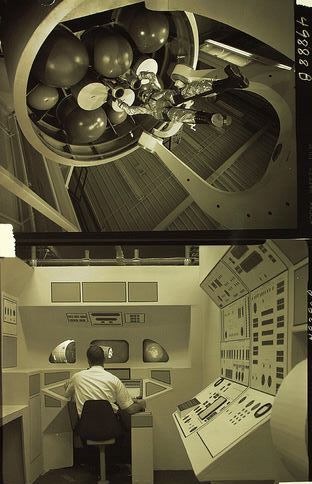 MOL training and mockups. The MOL astronauts never did any mission training before the program was canceled. But they worked closely with the design engineers to determine human-machine interfaces. (credit: NRO) |
Although MOL was first and foremost a visual photo-reconnaissance spacecraft, the authors noted that throughout history the military use of technology had always evolved and human spaceflight was no exception. As President Johnson had publicly stated the previous summer, the United States had to put man in space to figure out what military missions he could do there.
| The authors argued that MOL was also shouldering the initial down-payment on a useful capability to have military astronauts in space. |
There were also other possible missions. They noted that Kodak had performed an in-house study of the feasibility of using the current camera configuration for a still-classified purpose, which was most likely photographing other spacecraft in orbit. They also thought that the astronauts could perform signals intelligence from MOL. In fact, a SIGINT payload named DONKEY was developed for MOL but ultimately flew on a robotic spacecraft in 1967. (See “The wizard war in orbit (part 3)” The Space Review, July 5, 2016).
The report stated that “we believe that insufficient emphasis has been placed on the capability which the current system will provide in crisis situations,” and added that MOL might be useful in assisting in the Vietnam War. Probably due to the lack of time, they did not discuss any of these other potential missions in the detail they had devoted to the primary mission.
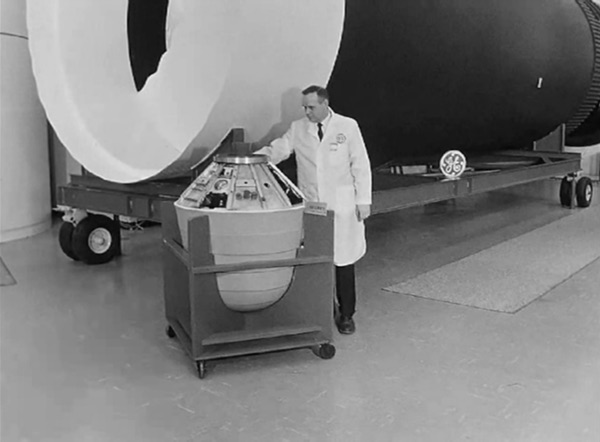 Screengrab from a declassified film about the MOL’s DORIAN camera system. The engineer is standing next to a mockup of a reentry vehicle. An unmanned version of the MOL would carry up to eight of these reentry vehicles, leading people familiar with the program to question why astronauts were needed at all. (credit: NRO) |
Of course, lurking behind all of these considerations was the big question of cost. MOL was an expensive project, and it was starting to experience the first of several major cost increases. But the authors argued that MOL was also shouldering the initial down-payment on a useful capability to have military astronauts in space. “Once the price for man is paid, his flexibility, his adaptability, and his immediate and highly responsive ‘reprogrammability,’ comprise unique contributions which can be exploited for some or all of (the) other missions, with cost outlays being principally confined to an increment associated with the particular mission. In contrast, unmanned approaches to performance of new missions are usually approached on a one mission type per vehicle configuration. New missions, unmanned, usually involve new development, major new costs, and usually are faced with a low initial reliability.”
The authors conceded that decision-makers were facing current budget limitations, not considering long-term investments. “We fully recognize that the argument above probably would have relatively little weight in high-level considerations of whether or not man should be part of MOL. The future is as yet nebulous, whereas imminent decisions may have to be based on current and near term military requirements and all-important economic considerations. Nevertheless, if the short-term view is to be taken, it should be fully acknowledged that the decision is based on a narrow view, and with full acknowledgement that long range considerations and implications are being ignored.”
The May 1966 report on the role of man in MOL indicates a lot of thought and careful evaluation by the study group rather than a rush to justify something that the senior leadership already wanted to do. For example, they noted that it was important to consider that the unmanned MOL was not optimized for the mission, so direct comparisons required caveats. They also implied that adding in the capability to fly MOL in an unmanned configuration might require compromises to the manned vehicle. Thus, they were not currently comparing optimized manned and optimized unmanned reconnaissance systems, and a study based upon different assumptions about the vehicles could reach different conclusions.
The authors also acknowledged that there were good and bad ways to use astronauts in a spacecraft. For example, an astronaut could be given trivial tasks merely because he was available and an engineer might use the astronaut as a shortcut rather than designing a better system. Doing this could lessen the astronaut’s capability for optimum performance of important mission tasks. They had learned from NASA that astronauts were sometimes given non-essential tasks simply because they were in the spacecraft.
At the time, the MOL program had only eight astronauts and the authors concluded that the program was not using them properly. They were spending three days of every week at Aerospace Pilots School, meaning that they were not working for the program during that time. “We should investigate procedures used by NASA to insure astronaut input into systems design,” they wrote. Eight crewmembers are “too few to cover in depth all areas in which they should be actively engaged” and they suggested that the next astronaut selection be done earlier in order to bring more people into the program to assist with human-machine interface issues.
| The authors must have received word from NASA managers that the Mercury and Gemini astronauts had become a bit too powerful within the civilian space program, because the report also included a cautionary note that NASA gave their astronauts too much say in designing system and flight operations. |
The study group concluded that “the participation of MOL crewmen in the engineering design of MOL to date had been very beneficial” and the engineers needed to be more involved. For example, MOL astronauts had suggested a method of improving the Gemini’s inertial guidance system so that it could be made ready in orbit significantly faster than the system then in use by NASA. The MOL crewmen had also successfully argued for inclusion of a window in the spacecraft.
There were other areas where the MOL astronauts had expressed concern about current plans for the spacecraft. For example, they noted that the umbilical hose was not long enough to permit external access to the entire vehicle during a spacewalk. In addition, the plan at the time was for a black-and-white TV display for selecting targets for the DORIAN camera system. But the astronauts believed that a direct optical acquisition scope, which would allow them to view the targets in color, was a better approach. This required a tradeoff to see which was better. Ultimately, program managers chose a direct optical scope.
The study participants also thought that the program could benefit by including current NASA astronauts in engineering design. The best approach would be to provide one or two NASA astronauts with security clearances so they would have access to the entire program. But apparently this idea had already met some opposition. “We believe reluctance to grant clearances to NASA astronauts might be overcome by proposing to select only those who are no longer considered by NASA to be active candidates for orbital flights, e.g. astronauts Slayton and Sheppard.” But they concluded that no matter which NASA astronaut was ultimately chosen, this was very important and a method should be found to include NASA astronauts as advisers to MOL. “It is inconceivable that we should overlook this unique source of experience.”
The authors must have received word from NASA managers that the Mercury and Gemini astronauts had become a bit too powerful within the civilian space program, because the report also included a cautionary note that NASA gave their astronauts too much say in designing system and flight operations. A military program could limit that, they felt. “We consider it mandatory that their input be absorbed into the program decision-making machinery in an orderly, non-disruptive manner.”
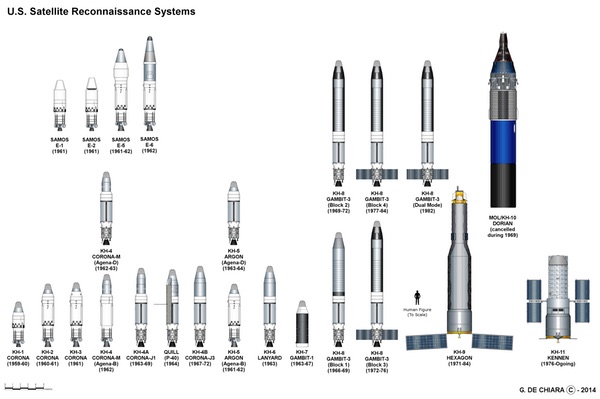 A comparison of U.S. reconnaissance satellites up to 1976. By the time MOL was in advanced development, the National Reconnaissance Office had been successfully flying robotic reconnaissance satellites for many years. [larger version] (credit: Giuseppe De Chiara) |
The report’s major recommendation was for a comprehensive study comparing the capabilities and reliability of manned and unmanned MOL vehicles. The authors believed that there was sufficient data on both types of space vehicles to make a detailed analysis, and this should be undertaken immediately. According to other records, that work began even before the study was finalized.
One of the recurring themes apparent in the report is that the authors believed that the manned MOL was perpetually requiring justification. Although MOL was not even a year old, they believed that this argument would continue for the rest of the program. They even suggested that the program office create a periodic review process to continually update the justification for including astronauts in the program. But although they thought there was a solid justification for military astronauts, the report conveyed a tone of mild defensiveness, as if they were resigned to eventually lose to the unmanned MOL. New developments in robotic reconnaissance systems—notably the impending launch of the first GAMBIT-3 high-resolution reconnaissance satellite only a few months after the report was finished—were eroding the justification for having a man controlling the camera on a big spacecraft. Indeed, during an interview in 2015, former MOL astronaut Al Crews stated that when he saw some of the high-resolution photographs coming back from the GAMBIT, he knew that the MOL program’s days were numbered.
One bit of foreshadowing in the report was a reference to concerns about MOL expressed within the President’s Science Advisory Committee. PSAC was a high-level advisory group that had played a major role in numerous important intelligence and military decisions since the 1950s. PSAC had previously made recommendations on satellite and ICBM programs. Although no PSAC reports about MOL have been declassified, if PSAC’s members were skeptical of MOL, MOL’s program managers would have been worried, because PSAC could speak directly to President Lyndon Johnson.
Another issue that affected the views in the report was its timing compared to other spaceflight events. NASA’s Gemini flights were then underway, demonstrating the versatility of astronauts in low Earth orbit. MOL would use a version of the Gemini spacecraft, which made program officials acutely interested in NASA’s ongoing missions. But the timing of the report may have also affected its conclusions. The report mentions the Gemini 6, 7, and 8 missions as important demonstrations of the value of an astronaut in space, stating that “anything man has been able to do in aircraft from a military mission standpoint he can do in orbit.” When a thruster on Gemini 8 malfunctioned, the astronauts were able to overcome the malfunction, although the mission ended.
| By fall 1967, the program revisited the question of the value of astronauts aboard a manned reconnaissance spacecraft, and this time they had charts and graphs to back them up. |
But in June 1966 Gene Cernan experienced major problems performing a spacewalk during the Gemini 9 mission, an event that demonstrated some of the limitations of human spaceflight—humans did not always solve problems, sometimes they became the problem. In July 1966, Mike Collins performed EVAs on Gemini 10 with fewer problems, and by the end of the Gemini program EVAs were well understood. But these experiences demonstrate that if the MOL report authors had to consider the Gemini 9 experience, they might have been less optimistic about the ability of astronauts to overcome problems in space—timing was everything.
The MOL program office quickly began implementing many of the recommendations in the report and throughout 1966 and into 1967 program managers, with the assistance of an enlarged MOL astronaut corps, began conducting simulations and modeling of the astronauts’ ability to maximize the potential of the Manned Orbiting Laboratory and its powerful DORIAN camera. By fall 1967, the program revisited the question of the value of astronauts aboard a manned reconnaissance spacecraft, and this time they had charts and graphs to back them up.
Next: Evaluating the role of man in MOL, part 2.